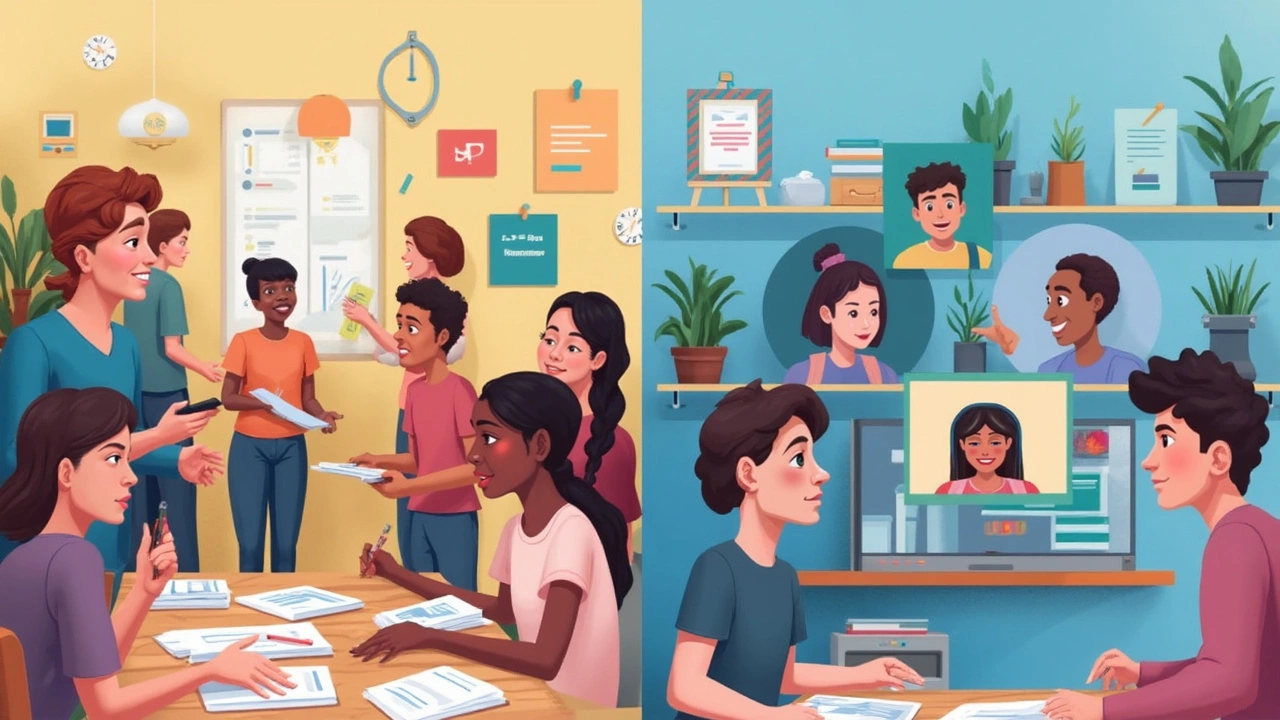-
1
- 0

Is Homeschool the Same as Online School? Key Differences Explained
Mixing up homeschool and online school is super common—and honestly, the differences are not that obvious until you jump in. At first glance, both keep kids out of a traditional classroom and use the internet to learn. But they work in totally different ways.
Homeschool puts parents in charge of what, how, and when their kids learn. You could use old-school textbooks, hire a math tutor, or spend an afternoon at the science museum. Nobody's handing you a schedule—it's more like build-your-own school from scratch.
Online school, on the other hand, usually means signing up with an organized program. There’s a set curriculum, a roster of real teachers, and a schedule that sometimes feels a lot like regular school—just without the bus stops and cafeteria food. Both options have their perks, but your family's needs and your kid's learning style really shape which one works best.
- Homeschool vs. Online School: The Core Difference
- How Learning Happens in Each
- Legal Stuff & Age Requirements
- Daily Routine and Flexibility
- Tips for Making the Right Choice
Homeschool vs. Online School: The Core Difference
The confusion between homeschool and online school usually starts because both keep kids learning from home, but how they work is actually pretty different. In homeschooling, parents call the shots—they pick what to teach, how to teach it, and even when the learning happens. You can mix and match resources: workbooks, YouTube, library trips, or even just a walk outside for nature science. Some parents use boxed curriculum sets, but they still steer the ship and tweak things if their child needs something different.
Online school isn’t so DIY. It’s more like being enrolled in an official school program. The school lays out the courses, and licensed teachers handle lessons and grading—even if that means video lessons and digital quizzes. Most public online schools have to follow state standards, take part in standardized tests, and report attendance. Parents act more like learning coaches, helping with motivation or tech support, but they don’t make the lesson plans.
Here’s a simple breakdown:
- Homeschool: Everything is controlled at home. Parents are the teachers. The curriculum and schedule are flexible and often custom-made.
- Online School: Students enroll with a school (public or private). Teachers assign work, give grades, and follow a set curriculum. Kids often have classmates—at least virtually—and set deadlines.
Another big difference? Accountability. Homeschoolers answer mostly to their state’s homeschool laws, which can be super flexible or pretty strict, depending where you live. Online students have to stick with their program’s rules, much like a regular school. So, while both keep you out of a traditional classroom, your daily experience and responsibilities look pretty different depending on which path you choose.
How Learning Happens in Each
How kids actually learn in homeschool versus online school is where things get real. It isn’t just about where you are or what’s on your screen. The behind-the-scenes setup, the way lessons roll out, and who’s in charge are all totally different.
In homeschool, parents (or sometimes hired tutors) run the show. You pick the subjects, set the pace, and decide what counts as a ‘lesson.’ One family might do reading and math before lunch, then hit the park for science. Some homeschoolers subscribe to boxed curriculum kits that come in the mail. Others hunt for cool free worksheets online or build lessons around documentaries and field trips. There’s no school-issued report card unless parents make one themselves. You can go all-in on Shakespeare one month, then switch it up if the kids get bored.
Now online school is more structured. You enroll in a program—sometimes it’s run by a state, a private company, or even a public school that just operates online. Students log in to a portal with video lessons, digital assignments, and sometimes live classes with other kids. There’s a clear path from start to finish for every grade. Real teachers check in, give tests, grade homework, and keep track of attendance. Everything is tracked, so if your kid is behind on math, the curriculum won’t move on until they’re caught up.
Here’s a quick side-by-side to show what it looks like in the real world:
| Homeschool | Online School | |
|---|---|---|
| Who Teaches? | Parent/tutor | Certified teachers |
| How Lessons Work | Flexible and chosen by parent | Set by the course or school |
| Tracking Progress | Parent decides; can be casual | Assignments and grades tracked by school |
| Access to peers | Organized meetups or co-ops | Classmates online |
| Schedule | Up to you | Usually follows a fixed or suggested schedule |
The biggest thing: homeschool is built around your choices; online school is built around a program. According to the National Home Education Research Institute, nearly 3.1 million students were homeschooled in the U.S. in 2023, while over 4.5 million enrolled in full-time online learning. A lot of families find online school feels closer to traditional school, just in a different format—it often comes with all the homework, tests, and grading you’d expect. Homeschool can be totally personalized and is only as structured as you make it.
If your kid needs more support or you want regular feedback, online schools might work better. If you want freedom and flexibility, homeschooling opens those doors—but you’ll be the one running point much of the time.

Legal Stuff & Age Requirements
If you’re thinking about switching to homeschool or online school, the rules aren’t just the same everywhere. In the U.S., for example, every state decides its own laws on homeschooling. Some states are chill—you just fill out a form that says, “Hey, I’m homeschooling my kid.” Others want you to send in a yearly lesson plan, keep attendance records, and sometimes even do state tests.
Here’s the catch with homeschool: In most states, your child has to start school around age 5 to 7, which lines up with regular kindergarten or first grade. Parents usually need to submit a notice of intent to homeschool to their local school district before pulling their kid out of public school. Some states—think New York or Pennsylvania—ask for more paperwork and even home visits, while places like Texas just need a letter and you’re good to go.
Online school usually works a bit differently. If you enroll your child in an official online public or private school, you’re following their rules. Public online schools (like K12 or Connections Academy) follow all the standard state rules—sometimes even more. Students need to be the regular age for each grade, and parents fill out regular registration, just like with any public school. Private online schools can set more of their own rules, but they still check your child’s age and grade level before letting you sign up.
Here’s a quick list of what you’ll usually need for either option:
- Proof of your child’s age (birth certificate works)
- Current address (for the school or the local district)
- Immunization records (some states require them, even for homeschoolers)
One more thing: If your child has special needs or an IEP, homeschooling or certain online schools may ask for extra paperwork. Also, military families and people moving states need to double-check the local rules—what’s fine in one state can get you in hot water in another.
Daily Routine and Flexibility
How your day looks totally depends on which route you take—homeschool or online school. Homeschoolers get the most freedom. You can start at 9am or noon, tackle subjects in any order, and pause if real life (like an appointment or a family trip) pops up. Some families do short lessons every day, others do longer chunks just a few days a week. You can even focus on tough subjects when your kid’s energy is highest, instead of forcing algebra first thing.
If you choose online school, expect more structure. Most big programs run on a live class schedule, with set times to join video calls and submit assignments. You’ll still be at home, but classes might start at 8:30am sharp because actual teachers are waiting. Some programs are flexible about when you do the work, but many have daily check-ins, quizzes, and deadlines. It’s not always easy to travel or handle mid-day errands since attendance often matters.
Here’s what typically shapes each daily experience:
- Homeschool: Flexible pacing, self-made breaks, no "tardies" or absence records, and lesson plans you control. Perfect for families with busy lives, special needs, or kids who thrive off routine tweaks.
- Online School: Pre-set class times, required attendance, teachers accessible during "school hours," and assignments with firm deadlines. If your family likes predictability and built-in accountability, this helps keep you on track.
When looking at your kid’s personality and your own schedule, ask what kind of structure you both actually need to get things done. Some kids love the flexibility of homeschool, but others feel lost without a ready-made schedule. Knowing who needs what makes all the difference when picking between these two options.

Tips for Making the Right Choice
Choosing between homeschool and online school is a big deal—it’s not just about academics, but your whole family’s routine and peace of mind. Start by looking at your schedule and resources. If you have a flexible work setup and like creating custom lessons or projects, homeschool usually lets you call the shots. But if you need more structure, or your teen learns best with set deadlines and teacher feedback, an online school could be a better fit.
Before you decide, check the legal bits for your state. Some places have strict requirements for homeschool records or testing, while online schools (especially public or charter versions) usually handle all that paperwork for you. You can find this info on your state’s department of education site—don’t skip it, because ignoring reporting rules can cause real headaches.
Think about your kid’s learning style. Some kids really thrive with hands-on experiments or field trips that homeschooling makes easy. Others do better following a regular online school day with video classes, assignments, and due dates. Ask your child how they like to learn—some families even try out both styles for a month and see what sticks.
If you’re worried about social time, both choices offer options, but in different ways. Homeschoolers often build community with local groups, co-ops, or extracurriculars. Most online schools offer class forums, clubs, or even live sessions. Make a plan for this early so nobody feels alone.
Here’s a quick checklist if you’re still on the fence:
- Map out your weekly time and see how much adult involvement is doable.
- Research your state’s homeschool laws and online school accreditation.
- Read online reviews—real parents have a lot to say about day-to-day life with both options.
- Prioritize your child’s preferences—ask them to list what makes learning fun or stressful.
- Talk with experienced families in local groups or online forums. Firsthand advice beats marketing brochures.
Remember, you don’t have to be locked in forever. Families switch between homeschool and online school all the time if needs change. What matters is what’s best right now—not what’s trendy or what works for the neighbors.
Write a comment
Tags Weight
- education
- exam preparation
- study tips
- adult education
- online courses
- adult learning
- lifelong learning
- distance learning
- GCSE revision
- online education
- private tutoring
- special needs education
- scholarships
- remote learning
- scholarship tips
- financial aid
- international students
- effective learning
- e-learning
- education funding

Written by Elara Winslow
View all posts by: Elara Winslow